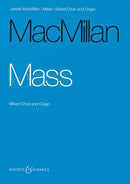| 作曲者 | James MacMillan (b. 1959)・マクミラン |
| タイトル | Mass |
| 出版社 | Boosey & Hawkes・ブージー&ホークス |
| 楽器編成 | mixed choir (SATB) and organ |
| 品番 | 9790060112997 |
| 言語 | 英語 |
| 形状 | 70 ページ・Saddle stitching |
| 演奏時間 | 35分 |
| 作曲年 | 2000年 |
| 出版番号 | BH 5402227 |
| ISMN | 979-0060112997 |
Unlike MacMillan’s congregational Galloway Mass and St Anne’s Mass, this work is on a grander liturgical scale befitting its commission by Westminster Cathedral for the Millennium. The drama of the liturgy is strongly conveyed in music combining atmosphere and mystery, enhanced by virtuosic organ writing. The Mass includes Kyrie, Gloria, Sanctus, Benedictus and Agnus Dei. In addition there are settings only for liturgical use of the Alleluia, Sursum Corda, Preface and the Eucharistic Prayer right through to the Great Amen. The congregation may join in with the Memorial Acclamations and part of the Great Amen. In its devotional spirit this Mass reflects MacMillan’s own faith, and his conviction comes strongly off the pages of this effective and original work. MacMillan likes to create atmosphere in his music and knows how the mystical can interact with the music to make a powerful impression on the listener, especially in the context of a great religious building. His organ parts are often repeated ‘filigree’ figures which create a background ‘wash’ of sound, as in the Kyrie here (and A New Song). The contrapuntal writing in the Kyrie is wonderful and creates a true sense of forward motion. The power of the chordal passages which come later is then put in proper relief. The final Kyrie is more difficult than the earlier sections, with angular intervals for the trebles/sopranos to negotiate. The Gloria begins with a strong statement for upper voices including a top B (MacMillan likes to use extreme range in the outer voices of his music generally). This movement makes much use of melismas which feel as if they grow out of plainsong melodies, having a similar feel of rhythmic freedom. There is a wonderful ATB section (We give you thanks…) which really needs singers who can sustain lyrical lines. The Sanctus is a real tour de force, being a very extended crescendo which starts very low (F sharps) with basses pianissimo and builds up to a simply massive climax. The Hosanna needs an agile organist and includes more of MacMillan’s vocal ornamentation referred to above. The Benedictus follows segue and is slow moving, eventually building to another huge Hosanna which subsides again into the dark abyss from which the Sanctus began. The Agnus Dei is more difficult than the other movements and in finding its way to a kind of resolution in its ‘grant us peace’ MacMillan acknowledges that the music reflects ‘the doubts and fears which characterize our time’. The final repetitions of the word ‘peace’ are punctuated by low clusters on the organ which sound like distant explosions. It is wonderfully effective music.
Kyrie - Gloria - Alleluia - Sursum Corda - Preface of Sundays in Ordinary Time I - Sanctus and Benedictus - Eucharistic Prayer II - Memorial Acclamations - Agnus Dei - Appendix: Preface of the Holy Eucharist II



